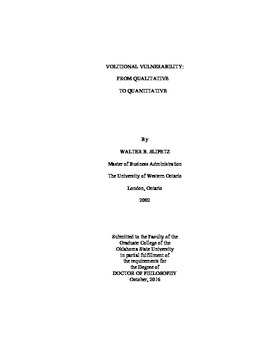Volitional Vulnerability: From Qualitative to Quantitative
Volitional vulnerability: From qualitative to quantitative
| dc.contributor.advisor | Wallace, Craig | |
| dc.contributor.author | Slipetz, Walter B. | |
| dc.date.accessioned | 2018-06-25T13:38:32Z | |
| dc.date.available | 2018-06-25T13:38:32Z | |
| dc.date.issued | 2016-10 | |
| dc.identifier.uri | https://hdl.handle.net/11244/300269 | |
| dc.description.abstract | This paper introduces a newly developed psychometric measure called volitional vulnerability. Results of the present study show how the qualitative theory of vulnerability as set forth by Dr. Brene Brown can be expressed as a quantitative psychometric measure and how that same measure can be utilized as an effective predictor and mediator of other well-established research constructs such as psychological safety and organizational citizenship behaviors. The study of volitional vulnerability contributes to a deeper understanding of the theories of psychological safety and organizational citizenship behaviors. Expressed as a three-factor psychometric measure, volitional vulnerability shows significant and positive associations to these constructs and acts as a partial mediator between them. Courage, compassion and connection appear to play a role in these associations and act in a way to support their articulation. Volitional vulnerability may play a significant role in image management as it relates to psychological safety and is potentially a heuristic to support decision-making in the expression of psychological safety and organizational citizenship behaviors. In review of the hypotheses tested, this study provides empirical evidence that the three factors of vulnerability--courage to be imperfect, connection, and compassion--are essential elements of volitional vulnerability as predicted by Dr. Brown's theory. Second, there is a positive and significant association between psychological safety and volitional vulnerability. Third, volitional vulnerability is a positive and significant contributor to the prediction of organizational citizenship behaviors. Fourth, psychological safety is a positive and significant contributor to the prediction of organizational citizenship behaviors. Fifth, results of this study show that the path between psychological safety and organizational trust is not significant. Sixth, volitional vulnerability is a partial mediator along the decision-making path between psychological safety and organizational citizenship behaviors (Indirect / Total effect = 11.4%) but has no significant mediating effect between organizational trust and workplace performance results. Seventh, the association between organizational trust and volitional vulnerability was not statistically significant. Finally, volitional vulnerability and psychological safety are not significantly related to workplace performance results. Implications of these findings are considered. Contributions to theory and practice are reviewed. Limitations and future research are discussed. | |
| dc.format | application/pdf | |
| dc.language | en_US | |
| dc.rights | Copyright is held by the author who has granted the Oklahoma State University Library the non-exclusive right to share this material in its institutional repository. Contact Digital Library Services at lib-dls@okstate.edu or 405-744-9161 for the permission policy on the use, reproduction or distribution of this material. | |
| dc.title | Volitional Vulnerability: From Qualitative to Quantitative | |
| dc.title | Volitional vulnerability: From qualitative to quantitative | |
| dc.contributor.committeeMember | Edwards, Bryan | |
| dc.contributor.committeeMember | Arnold, Todd | |
| dc.contributor.committeeMember | Sagarnaga, Jose | |
| osu.filename | Slipetz_okstate_0664D_14911.pdf | |
| osu.accesstype | Open Access | |
| dc.type.genre | Dissertation | |
| dc.type.material | Text | |
| thesis.degree.discipline | Business Administration | |
| thesis.degree.grantor | Oklahoma State University |
Files in this item
This item appears in the following Collection(s)
-
OSU Dissertations [11222]
